INTERVIEW WITH JAYE ANNA MIZE AT FS (FASHION SNOOPS)
Stay tuned for changes in home furnishing design aesthetics, customer moods
and purchasing preferences that will roll out in 2023-24.
It’s been over a year since Furniture World spoke with Jaye Anna Mize
about consumer behavior, culture, lifestyles and future home furnishings
trends. She is Vice President of Home Interiors and Lifestyle at FS (Fashion
Snoops), a leading global trend agency and consumer behavior think tank. FS
works with retailers and brands in the fashion, beauty and home furnishings
industries serving clients that range from luxury to mass market.
We asked her to share insights and buying suggestions based on FS’
Fall-Winter 2023-24 forecast, launched on
www.fashionsnoops.com.
Throughout this article, Mize references the terms Design Aesthetics,
Cultural Aesthetics and Seasonal Design Shifts. The distinctions are based
on FS’s seasonal forecast that begins by defining key Cultural
Sentiments that address core consumer movements affecting design. From
there, FS determines how those movements interact through color and design
priorities from a cross-market application, calling them Design Aesthetics.
The Seasonal Design Shifts Mize talks about are forecasts for emerging home
furnishings over a designated time frame.
A Traditional Resurgence
Jumping right into a conversation about what home furnishings shoppers will
be looking for over the next few years, Mize said, “The fun part is
that retail showrooms are going to be more maximalist with a mix-and-match
approach to the way rooms are put together.
Consumers will be receptive to a variety of eclectic style choices running
through their rooms and homes.
“We will see more traditional-inspired furnishings in a multitude of
flavors from Venetian to Russian—think Catherine the Great! Quality
over quantity will become even more important. This is a conversation we
started two years ago, which will hit furniture hard in the next year with
the Nuance Design Shift coming to the forefront. There will be more ornate
designs, opulent curves, scalloped architecture, gilded window sets and
Victorian-era decorating.
“We’re seeing a resurgence of Italian, French and English
architectural influences, partly due to revenge travel. It reflects a desire
for home furnishings shoppers to incorporate escapism in American homes more
than ever.
“Millennials and even some sectors of Gen Z are really getting excited
about traditional, although for younger Gen Zs this interest can be from a
secondhand-sustainable perspective.”
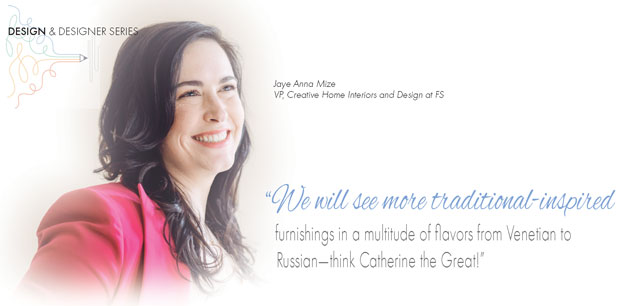
Nuance Seasonal Design Shift
Old-World Venetian and golden era home furnishings are re-purposing and
reformulating the design landscape. FS’ latest report says that
Nuance’s origins stem “from the desire to create meaningful
moments, travel continues to inspire heirloom-like pieces, encouraging the
mix of old and new forms.”
Mize observed that except for a shabby chic period in the ‘90s, a
romantic home furnishings moment hasn’t emerged in quite some time.
“During the pandemic, we had the Cottagecore aesthetic. Now consumers
are in traveling mode, bringing hardcore travels—their Italian,
Grecian and French flairs—inside along with beautiful earthen
palettes. I wouldn’t necessarily call it maximalism which seems too
kitsch. It’s more refined with a focus on craftsmanship and often a
connection with a maker. This new traditional design features burl wood,
scalloped edges, carvings, large-scale botanicals and textured velvets.
These are coming back alongside more washed linens and jacquards. We are
seeing nested and conversational seating arrangements as well. Unique plays
on old-world Scandinavian fireplaces and mantelscapes have popped up
everywhere.” Takeaways from this shift in consumer preferences include
what FS identifies as Old-World Charm, Mix of Old and New, Italian Romance,
Large Scale Botanicals and Timeless Serenity.
“Better quality case pieces have trended modernist over the past few
seasons. For ‘23 and 24,” Mize said, “retailers should
prepare for a more romantic era of traditional with softer plays on waves
and arches. Especially here in the U.S., people will look for items that
connect them with their roots. Get ready for a resurgence of antiquity
themes, sometimes with an added touch of whimsy. Small details, cozy and
nook-focused furnishings as well as secondhand and ‘found’
furniture has become popular. People want to incorporate maker craft
furnishings and artisanal finds in their homes.
“Furniture World readers should also be on the lookout for the
continued integration of velvet into a multitude of different areas.
It’s a very bold look.”
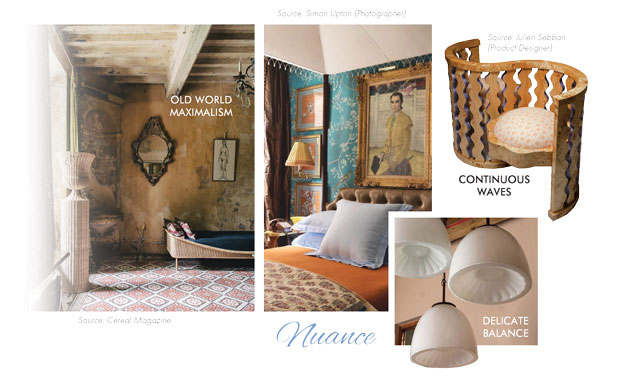
Diffuse Seasonal Design Shift
According to Mize, Traditional is one slice of the pie.
“Another,” she explained, “is Diffuse, a softened focus on
traditional that FS calls Contemporary Farmhouse, an elevated farmhouse
look. Included are natural combinations with tons of reclaimed woods and
brown marble coming to the forefront, often paired with brushed brass for a
fresh look. Clay, amber glass and really fun new artisanal interpretations
of recycled waste are part of this aesthetic. Oak is a key element in
Contemporary Farmhouse design, but with a much softer look than some of the
whiter oak finishes people are more familiar with.” FS’
takeaways include: Returning to the Foundations of Life, Daily Rituals,
Farmhouse Reimagined, Conscious Craftsmanship and Authentic Creation.
“Mize noted that “From a detail perspective, Diffuse designs
have deeper ribbings, lots of playful inlays and paneling. It’s a
slightly different twist on Farmhouse that expands its appeal to urban
settings, as well as suburban and second homes.”
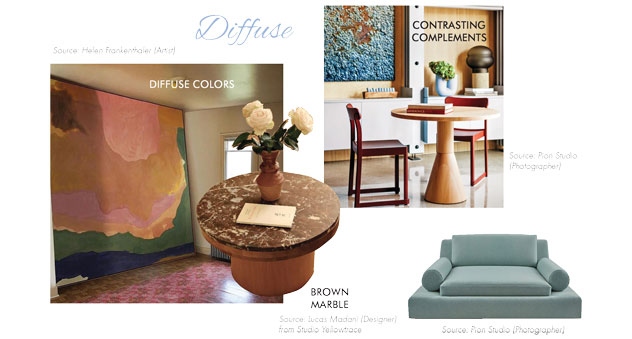
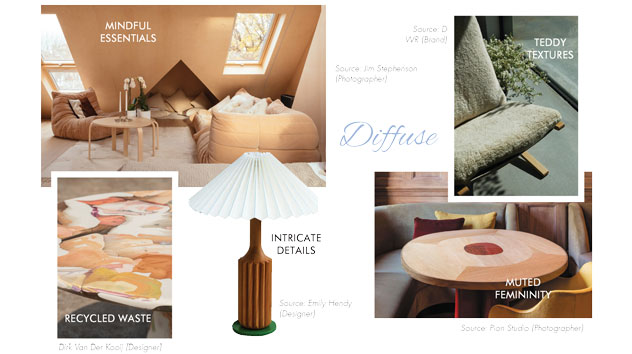
Euphoric Seasonal Design Shift
FS describes Euphoric as taking “us on a journey through exciting yet
uncharted territories. As consumers desire innovations that allow a
momentary escape from our physical reality, futuristic forms create fluid
transitions into a metaverse full of unique immersive spaces.“
That’s quite a mouthful and a new way to look past more traditional
design to a more digitally inspired future.
“The youngest furniture shoppers,” observed Mize, “are
looking for metaverse and tech-integrated furnishings. Alphas and younger
Gen Zs have developed a preference for items in the real world that mimic
their decorating choices in gaming platforms like The Sims or Fortnite.
It’s a small beginning to an enormous shift toward what we call
Euphoric Design.
“At the recent High Point Market,” she continued, “Nathan
Anthony showed furniture designs that fit perfectly within this
metaverse-inspired aesthetic. There were funky bases, legs that had more
depth and a lot of interesting fabrications reminiscent of clouds,
incorporating rolling curve shapes. Also, huge iridescent, opulent shines
are really important to this shift.”
“Euphoric Design includes some interesting nostalgic throwbacks that
are, in some ways, a new version of a futuristic ‘60s and ‘70s
aesthetic with an otherworldly feel.” Mize calls some of the more
playful, contoured creations ice cream constructions. “They
are,” she said, “comfortable and crafted of a soft-looking
resin. It’s an Eames aesthetic updated for this metaverse feel. Urban
Outfitters has started to address this market in a fun way. It’s a
minimalism that’s monochromatic but feels elevated and almost
futuristic. There’s a sense of harmony, repetition and balance.”
Key takeaways from FS include: Futuristic Dreamland, Conforming to Our
Surroundings, Innovative Developments, Continuing Curves and Monochromatic
Minimalism.
Elaborating on Gen Z preferences, Mize said that this group is “much
more willing to shop secondhand than for what they consider fast fashion
home. They are done with plasticky furniture that looks like it might fall
apart in six months. This is true across younger consumer groups who want
their furniture purchases to have a quality feel that’s in line with
their sustainable mindset.”
“Soft browns and earthier greens are coming to the forefront. Sky blue
will become popular in Spring 2023. Color prints and patterns will be
important at retail.”
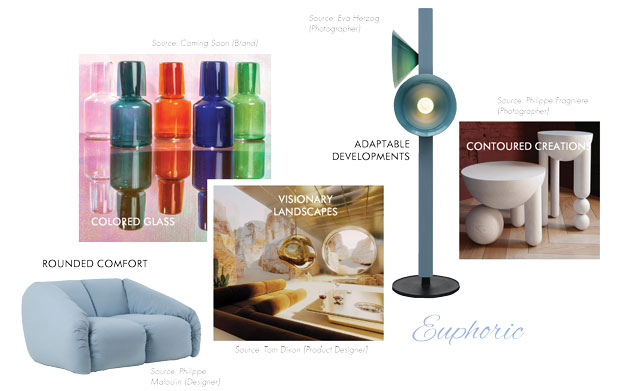
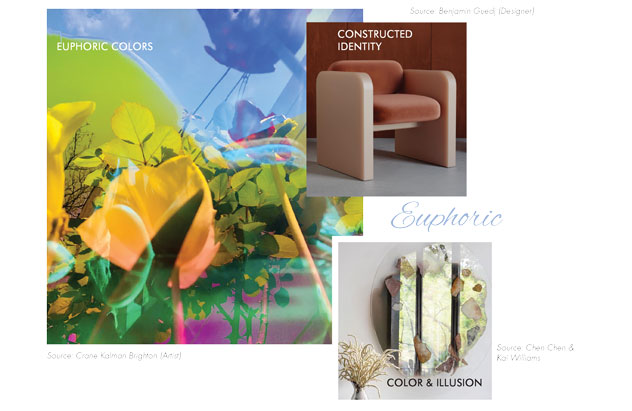
Transcendental Design Aesthetic
“This story is highlighted by a darker home-set coming to the
forefront,” Mize explained. “The focus is more spiritual,
balanced and harmonious. Transcendental is associated with a consumer desire
to decipher what spirituality means to them in this new age. Millennials are
redefining how to incorporate spirituality, mindfulness and self-care into
their lives.” FS describes this Design Aesthetic as a consumer need to
take “note of the consumer’s new rituals and applications
towards soul care that center around symbology and the darker elements of
nature.” Takeaways include: New Awakening, Meditative Quality,
Contemporary Symbology, Systemic Balance and Moody Ambiances.
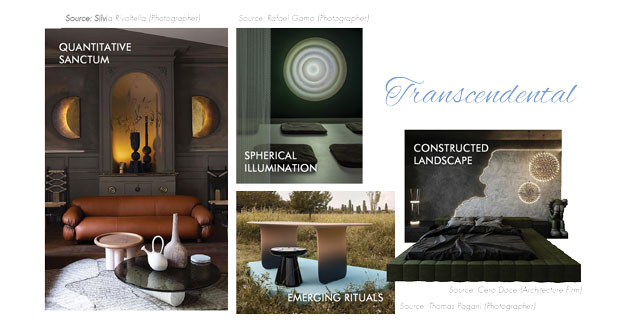
Symbiotic Seasonal Design Shift
FS reports that Symbiotics reflect a consumer desire to find comfort in
natural materials. They are willing to “push creative boundaries as
they develop a deeper appreciation for mother earth. With sustainability at
the forefront of design, the conservation of our planet’s resources
influences the eagerness to adopt innovations that represent future
impacts.”
“The Symbiotic story is deeply nature-inspired. We’re seeing it
play out in fabrications that mimic eco-spaces,” explained Mize.
“It’s an almost intense nature infusion. Featured are green
colors and materials like recycled stained glass, seaweed textiles and kelp
yarns that grow like crazy and are a vast sustainable resource. Designers
seem obsessed with ocean themes right now and are using material
applications that have almost a forest-like feel.” Takeaways for
Symbiotic include: Designed by Nature, Reciprocal Earth, Eco Alternatives,
Cavern Comforts and Raw Richness.
“Coming to the forefront with Symbiotic,” added Mize, “are
zinc-treated applications, cement, composites and non-woven rattan, raw
earthy stones and imperfect elements. Architects are experimenting with
materials used in new homes and hospitality that feel a lot more organic.
Details include everything from aluminum and concrete mixes to glazed
patchworks, organic shapes and soil textures that mimic mother earth in
every way possible.
“There are also elements of Brutalist design playing out but with
added cozy, more familiar elements. These were everywhere at the Milan show,
where we saw a new use for reconstructed wood applications that will
probably only be adopted at a high-end luxury design level.”

Refuge: A Cultural Sentiment
FS describes this sentiment as “one where we come to accept the
constancy of change, conflict and uncertainty. We learn to adapt, seek out
products, environments and modes of expression that can respond to our every
need or desire and prep us better for what may come tomorrow.“
Mize said that grounding as a design theme “speaks to the Refuge
storyline. Earthen experiences are translated over into home architecture
and decor in interesting ways. These mimic or get their inspiration from
caves and underground spaces. Refuge is associated with an approach to
design that focuses on mindfulness.
“Some applications may seem a bit forward, but are still high design.
They feature transformed textile materials used in ways that might look like
a tree mended them together organically.”
She believes that this trend is rooted in the lifestyle choices of Gen Z.
“They have more transient lifestyles, shuttle between Airbnbs, live in
refurbished vans or off the grid. They seem desperate for a connection with
nature. Many Gen Zs and younger millennials feel this disassociation as a
desire to be surrounded by nature, right now seen primarily in higher-end
designs.
“Refuge aesthetics are coming to the forefront at hotels that want to
embrace off-the-grid design and a more mindful hospitality,” Mize
added. “For most home furnishings retailers, this aesthetic will take
two years to hit. Then, watch for themes like cavern comfort, more raw
richness, and lots of reciprocity with the earth.
“At retail, we are likely to see more grounded bedframes as bedroom
wellness becomes more important. These will be increasingly sophisticated,
incorporating unique upholstered treatments compared to typical wood or
metal construction. There will be some really nice mindfulness styling
coming to the forefront focused on personal care and rituals.
Refuge-inspired designs will incorporate the natural foundations of life
curated for consumers in an authentic way.”
Seen at High Point Market
Mize said, “Elements of the Nuance, Euphoric, Diffuse and Symbiotic
Seasonal Design Shifts were on display at the 2022 Fall High Point market.
Jaipur Living, for example, had a flora and fauna party that featured a
Symbiotic setup. Gabby’s bird sanctuary display spoke directly to the
Nuance theme, and Nathan Anthony was completely Euphoric. It was like Tina
Nicole and Khai Mai are designing for the metaverse and channeling a younger
Gen Z and Alpha mindset. Also displayed were more contemporary pieces that
fit solidly into the Diffuse arena, taking Farmhouse in a new direction.
“Almost every showroom had a teddy bear textured upholstered bed that
added a feeling of soft femininity. We also saw free-formed curves that
seemed to be channeling Sarah Ellison, the Australian furniture designer who
creates what I call ice cream-inspired furniture, including comforting sofas
and ottomans. It’s a very millennial and Gen X aesthetic.
“Lots of eco-innovations are another solid bet for retailers going
forward. You can find every type of slub fabric out there right now. At the
most recent Milan Fair, we saw upholstered applications that mimic fashion
sweaters. Even sparkle lurex fabric, typically used for 1970s fashion, has
found its way into upholstered furniture designs.
“Looking forward to the ’23-’24 seasons within the seating
category, fabrics will continue to become more slubbed and almost
antique-ish with fun looks plucked right out of the ‘70s.”
Newfound Heritage Lifestyle Movement
Furniture World asked Jaye Anna Mize to comment on how furniture retailers
might acknowledge the trend toward buying pre-owned furnishings.
She observed, “So far, retailers can take comfort in the fact that the
only demographic group that is heavily invested in buying non-antique
second-hand furniture is the Alphas, though more generally, people will be
buying and refurbishing more second-hand Americana.
“The Nuance and Diffuse Seasonal Design Shifts and a lifestyle story
called Newfound Tradition in our forecast speak heavily to that trend. The
Newfound Heritage story is an overarching movement that spans multiple
years. It addresses the consumer need to act as modern-day
curators/archivists of their homes and personal histories. Traditional
design motifs appeal to people searching for timeless modes of maximal
expression. The result is often an eclectic and globalized sense of design.
For them, mixing nostalgia with travel along their journeys is key.
“We didn’t talk a lot about nostalgia yet,” Mize realized
toward the end of our interview. “In times like these, when there is a
sense of political, economic, daily chaos, older generations gravitate
towards traditional design.
“There are some interesting statistics that reflect the nostalgia
described in our most recent forecast. Between 2021 and 2022, Pinterest saw
a 20 percent increase in searches for modern traditional. During the
pandemic, people took up hobbies that gave major boosts to platforms like
Etsy. Chairish reported that 31 percent of people in the millennial and Gen
Z cohorts increased their interest in buying used vintage or antique
furniture online.
“At FS,” she said, “we’ve broken this idea of
nostalgia down into three additional themes called Newstalgia, Return to
Tradition and Cross Culture.”
Newstalgia: “This theme addresses a willingness to
buy items such as chiclet chairs or the creations of Wilkes, Eames and
Herman Miller. Newstalgia includes the secondhand surges we’ve seen in
the market. Even Ikea has incorporated this secondhand thinking into their
designs by mimicking vintage razorback chairs or heritage Scandinavian
design. There are retro revivals, particularly in upholstery with
reintroduced paisleys, plaids and retro prints. Hobby culture, including
pastimes like crocheting, knitting and needlepoint, are pushing Newstalgia
forward as well.”
Return to Tradition: “Consumers want handmade items
that speak to a historical legacy. The hobby resurgence is a part of this
mix but focused on localized design. Food culture has moved in this same
direction as has a desire for furniture purchasers to know the maker of the
wood furniture they purchase. Along with that, we are seeing heirloom
materials and localized design, Victorian decorating and fun
elevations/reinterpretations of traditional designs becoming more
important.”
Cross Culture: “This theme looks at how traditional
design can be appropriated. It is a topic of concern, especially for younger
consumers. Cross Culture has come to the forefront in adventure and
discovery conversations, globetrotting and multicultural mixes.
“At present, Cross Culture is mostly of interest on the contract
hospitality side. In the retail home furnishings space, we are talking more
about materials and construction like using antiqued metals, refurbished
mahogany and old-school joineries that reference cultural stories. The
paisley prints, more scallops and ribbing I mentioned previously can all tie
Cross Culture in with the Diffuse and Nuance Seasonal Design Shifts. When
considered from a retail perspective, the design landscape is becoming more
eclectic than ever. For retailers, that means bringing diversity to product
assortments and considering cross-generational attributes that really speak
to nostalgia.”
Buyer’s Tips for 2023
Mize observed that the rate of change in furniture trends as they’ve
played out at retail—colors, themes, schematics, product
assortments—have generally slowed down over the past couple of years.
“Categories that will continue to evolve more rapidly are outdoor
spaces, decor, tabletop and soft goods, including top-of-bed pillows and
throws.”
She suggested that no matter how Furniture World readers are positioned, or
who their customers are, they should focus on color. “Soft
browns,” she said, “and earthier greens are coming to the
forefront. Sky blue will become popular in Spring 2023. Color prints and
patterns will be important at retail along with the colors tiki brown, burnt
sienna, brick red, chai spice and stormy sky blue. These are colors that are
comforting while still feeling fresh. Browns, in general, are becoming the
grounding base across the board, outweighing traditional greys and blacks.
Ochres, compost green, Spanish moss and olive hues are green casts that are
close to becoming new neutral colors. I believe that the color compost will
advance to the fore as the new navy. We haven’t been in this warmer
brown territory, even for wood tones, in a long time. They’ve been
grayed out but will be carried back onto retail floors as the palette for a
new traditional wave.
“Younger generations are going to diversify between secondhand and new
purchases with an emphasis on investing in quality over quantity. In 2023,
it will be a good idea for retailers to adjust product mixes toward smaller
pieces and away from big ‘Bubba’ items. The market will be more
accent-driven. People will look to improve their home decor but not
necessarily replace mainstay items like beds or large upholstered pieces.
Chests of drawers and side tables may perform better.”
Youth Furnishings
Mize told Furniture World that she sees a lot more emphasis on youth
furnishings. “Kids Home,” she told us, “is blowing up in a
big way. People spend much more on furnishing their kids’ bedrooms
than ever before. Some FS clients, the Big Lots, Targets and Walmarts of the
world, are increasingly focused on finding more innovative changing tables,
storage shelving, beds and top-of-bed products.
“The reason is that parents already have their bedrooms sorted, so now
they’re looking for new and interesting ways to keep their kids, who
are spending more time at home, busy in their rooms.”
“This phenomenon has also extended to colleges and
universities,” said Mize. “Check out RushTok, one of the biggest
trending things on TikTok. Students are getting rid of existing beds and
dorm furniture so their parents can outfit dorm and sorority rooms to the
nines. It is true that retailers are worried about a recession, but
there’s still a lot of money out there to be had by chasing
interesting home furnishings categories.”
Retail Trend Cadence
When asked how retailers, who are more promotionally-minded, might address
some of these forecasts, Mize noted that every retailer has its own trend
cadence. “Not every organization can be fashion-forward,” she
observed. “Sometimes a retailer needs to be one or two seasons behind
the actual timeline of a trend. We forecast two or three years out in
advance, but it is the storyline and the way that a trend will hit that is
most important. Consumer behavior tends to roll out in a continuous wave
that might hit a New York City staple like Bergdorf Goodman early and then a
mass-market furniture retailer in middle America a year or two later. Many
of our retail clients are still working off our 2021 or 2022 reports, while
others are already studying consumer behavior forecasts and planning their
buying strategies for 2025.”
Even though every retailer is different, Mize believes that no matter where
a retailer’s product selection is along the curve, it is important to
have a strategy and timeline. “Without that,” she concluded,
“it’s difficult to deliver inspirational seasonal displays in
place to anticipate customers’ buying moods and preferences for style,
selection, color and display.”